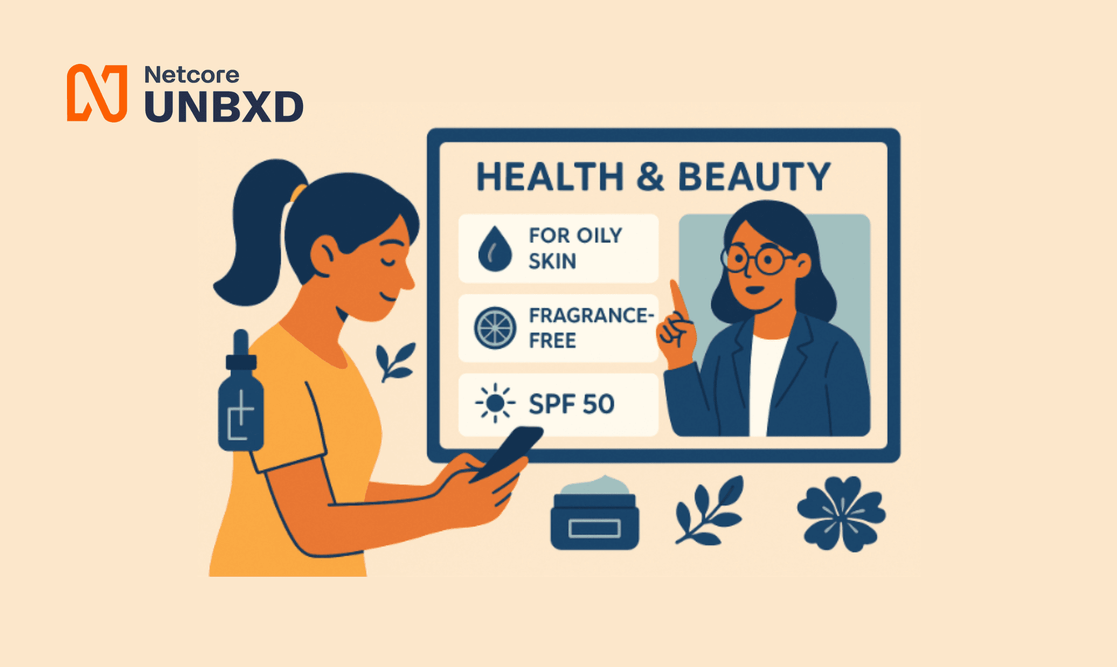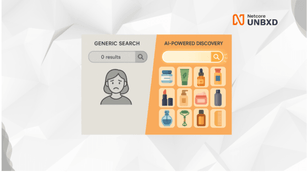- ProductsSearch and BrowseRecommendationsCustomer Engagement


The search bar isn’t just a discovery tool for health & beauty shoppers—it’s the closing aisle. A 2024 consumer study by Greenpark Digital found that 83% of buyers complete a skincare purchase after conducting an online search, while broader retail research indicates that 43% of visitors head straight to the search box the moment they land on a site.
Despite that sky-high purchase intent, most storefronts still fumble the hand-off. The result? Shoppers hit dead ends, bounce to competitors and, all too often, buy the wrong variant. Every flawed search experience is a double loss: the sale you never made and the return you still have to process. Catalog enrichment is how beauty brands break that vicious, leaky cycle, by teaching their catalog to speak the same nuanced, ingredient-rich language their shoppers do.
What is Catalog Enrichment?
Catalog enrichment is the art and science of meticulously enhancing, augmenting, and refining your product information beyond just a name and price tag. For H&B brands, this isn't a mere luxury; it's the very essence of creating a compelling online shopping experience. In an industry driven by ingredients, specific concerns (such as acne or aging), desired outcomes (radiant skin, voluminous hair), certifications (vegan, organic), and nuanced attributes like skin type compatibility or shade undertones, a rich and detailed catalog is essential. It's how you bridge the sensory gap of online shopping and guide customers to their perfect product match. Effective catalog enrichment is no longer just a good idea—it's a non-negotiable strategy for H&B brands to elevate customer experience, supercharge product discoverability, and ultimately, boost sales in a fiercely competitive digital marketplace.
Importance of Catalog Enrichment for Health and Beauty Brands
Improved Product Discovery for Specific Needs: Consumers in the health and beauty space often search for products based on precise criteria such as ingredients (e.g., "retinol," "hyaluronic acid," "paraben-free"), skin or hair type (e.g., "oily skin," "dry hair"), or specific concerns (e.g., "anti-aging," "acne-prone," "hyperpigmentation"). Catalog enrichment ensures these detailed attributes are accurately tagged to products, making them easily discoverable.
Enhanced Search Relevance and Reduced Zero-Result Searches: Without enriched data, a search for "vitamin C serum for sensitive skin" might yield irrelevant options or no results at all. Enrichment ensures that the search engine understands and matches these specific user queries with the most appropriate products, significantly reducing the chances of failed searches.
Effective Faceted Navigation and Filtering: Health and beauty shoppers heavily rely on filters to narrow down choices. Attributes like brand, skin concern, ingredient preferences, formulation (e.g., lotion, gel, serum), and certifications become effective filters only when the catalog is properly enriched. This enables customers to easily navigate and find products tailored to their specific needs.
Increased Trust, Transparency, and Consumer Confidence: By clearly and accurately listing all relevant attributes, such as "hypoallergenic," "non-comedogenic," "dermatologist-tested," or the absence of certain chemicals, brands can build trust and provide transparency. This is crucial for health-conscious consumers who carefully examine product details before making a purchase.
Better Personalization and Recommendations: Enriched product data allows ecommerce platforms to provide more relevant product recommendations and personalized shopping experiences. For instance, if a customer frequently buys products for "sensitive skin," the system can suggest other suitable items, increasing cross-selling and up-selling opportunities.
Higher Conversion Rates and Revenue: When customers can quickly and easily find products that meet their specific health and beauty needs, they are more likely to make a purchase, leading to increased conversion rates, higher revenue, and improved customer loyalty.
Why Netcore Unbxd excels at catalog enrichment
Traditionally, catalog enrichment for health and beauty products relied on manual processes or rule-based methods, where human curators manually tagged items based on visible attributes, such as "shampoo" or "lipstick." While effective in some cases, this method was slow and prone to errors, and couldn’t scale with large inventories or complex product lines (e.g., distinguishing between different shades of foundation or specific active ingredients in skincare). Missing details resulted in poor search relevance (e.g., a search for "hyaluronic acid serum" might only return "serum"), high exit rates, and zero-result pages that frustrated shoppers seeking precise solutions.
Today, AI-powered enrichment transforms this process by extracting meaningful, detailed attributes from product images and text, aligning them with search functionality at scale. Netcore Unbxd's AI-driven approach ensures speed, consistency, and accuracy in this specialized domain. Here’s how it works:
Identifying Missing Fields & Catalog Rating: AI scans the catalog to detect incomplete data, such as a moisturizer missing its "SPF level" or a makeup product without its "finish" (e.g., matte, dewy). It then assigns a quality rating to measure how well the catalog is structured for detailed product discovery.
Exhaustive Category-to-Feature Field Mappings: AI automatically maps relevant attributes to each health and beauty product category. For example, for "facial serums," it might map fields like "active ingredients," "skin type," "concern addressed," and "volume." For "hair care," it could map "hair type," "fragrance," "benefits," and "application method."
Using Intelligent, Trained Data to Enrich Missing Fields: Machine learning, trained on vast datasets of health and beauty product information, predicts and fills in missing attributes. This means that if a new lipstick is added, AI can expect its "shade name," "undertone," and "finish," even if these details are not explicitly provided, significantly improving search accuracy.
Reviewing the Catalog and Starting Indexing: The enriched health and beauty catalog undergoes validation to ensure accuracy (e.g., verifying that a product tagged as "fragrance-free" indeed is). Once validated, it's indexed, ensuring search engines can interpret and retrieve the right products, allowing shoppers to find exactly what they need.
How ResMed Enhanced Customer Experience through Catalog Enrichment
ResMed's journey illustrates the critical role of catalog enrichment in optimizing customer experience within complex product ecosystems. Facing challenges with search relevancy due to misspellings, unexpected spacing, and ambiguous user queries, ResMed recognized the limitations of traditional tagging and merchandising approaches. By adopting advanced catalog enrichment solutions from Netcore Unbxd—including automated keyword stemming, contextual synonym recognition, and intuitive merchandising capabilities—ResMed significantly enhanced its product discovery experience. This approach resulted in a 24% increase in revenue, a 21% uplift in conversion rates, and a 15% boost in customer engagement. These metrics reinforces that sophisticated catalog enrichment is not merely an operational enhancement but a strategic imperative for brands seeking deeper customer engagement and sustainable business growth in today’s competitive digital environment.
Conclusion
Your digital catalog is far more than just a list of products; it's your virtual storefront.. By prioritizing comprehensive catalog enrichment, H&B brands can move beyond basic listings to create truly informative, engaging, and high-converting customer experiences. It’s an ongoing commitment, but one that promises to unlock your e-commerce potential, build unshakeable brand loyalty, and let your unique products truly shine. Don't let a lackluster catalog dim your brand's brilliance – invest in enrichment and watch your H&B business glow.
Book a demo and see how catalog enrichment can let your customers find exactly what they want.


